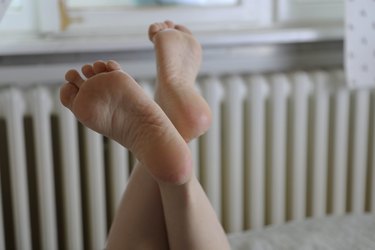
The first thing you should do if the bottom of your foot itches is so simple, you might forget: "Check your foot," Grace Torres-Hodges, DPM, board certified diplomate of the American Board of Podiatric Medicine in practice at Torres Hodges Podiatry in Pensacola, Florida, tells LIVESTRONG.com.
Sometimes the source is a bunched-up sock or something hanging out in your shoe that shouldn't be.
Video of the Day
Video of the Day
All clear? Flip your foot over and take a look at the skin, which might give you a clue as to what's going on. The source of out-of-control itch might come from direct causes (like a bug bite), a break in the skin that leads to infection or underlying medical problems, Dr. Torres-Hodges says.
To dive deeper into what might be going on, here are seven causes of scratchy soles:
1. Athlete's Foot
This common fungal infection — often picked up in gym or pool locker rooms — causes major itch.
"Your skin is your best barrier for any infection. Fungus will only irritate the skin if there's a break in its consistency. Skin that's too dry or too wet will begin to break down," Dr. Torres-Hodges says, adding that having this infection does not mean you're "dirty."
Once your skin is irritated, redness and inflammation will follow.
Fix it: Get checked out by your doctor, because this fungal infection can spread. It can also be caused by other problems, like hyperhidrosis (excessive sweating), as excessively sweaty feet can set the stage for an infection, notes the American Academy of Dermatology. You’ll also want to properly treat your shoes, otherwise they can re-infect your feet.
Related Reading
2. Psoriasis
Psoriasis is an autoimmune skin disease that can cause patches of thick, red skin and scales, per the Centers for Disease Control and Prevention.
"Any skin condition that causes rashes and dryness in the skin can result in itching. Interestingly, many times, podiatrists see psoriasis before the dermatologist, as patients come in with a skin rash that they think is an athlete's foot infection that's not responding to over-the-counter treatments," Dr. Torres-Hodges says.
Your podiatrist will also look for changes in toenails that can indicate this condition.
Fix it: If you’re diagnosed with psoriasis, you’ll also be referred to a dermatologist who can treat other areas of skin that are involved.
3. Skin Cancer
You'd never think that your soles could develop skin cancer, but it is possible.
"Think back to how many times you might lay out in your younger years. Did you put sunscreen on your feet?" Dr. Torres-Hodges says.
And so, both the tops and bottoms of feet can develop skin cancer, including melanoma.
Fix it: Get any itchy rashes, lesions or ulcers examined, she says, particularly any new, changing or unusual spots. These will have to be biopsied to determine if skin cancer is the culprit.
4. Contact Dermatitis
Contact dermatitis is just a fancy phrase for what happens when your skin comes into contact with something that triggers irritation and redness. Materials in shoes and socks can cause an allergic reaction on feet, Dr. Torres-Hodges says. She points to compression socks that may have latex in them as one possible offender.
If you go sockless and take off your shoes to find your feet are red and irritated (and it "looks like you're still wearing the shoe"), you may also be reacting to a fabric lining or coating in your shoes, she says.
Other common irritants include rubber and adhesive in shoes and nylon or acrylic-blend socks (undyed cotton socks are typically the least likely to cause a reaction).
Fix it: The solution here is fairly simple: Stop wearing the offending shoes or socks ASAP, and look for ones made with different materials.
5. Neuropathic Itch
Nerve damage, caused by conditions such as diabetes, can lead to neuropathy.
"This means that the patient has a problem with the nerve. The issue with neuropathy is that the patient just has a hypersensitivity or a chronic pain or itch sensation, so they are unable to perceive if the problem is physically there or not," Dr. Torres-Hodges says.
These issues in sensation, along with numbness, can lead to foot problems going undiagnosed, which can be dangerous.
Fix it: If you have diabetes, always talk to your physician about any foot problems you may be experiencing.
6. Cholestasis of Pregnancy
Are you pregnant? Then your ears should perk up about now.
Cholestasis of pregnancy is a condition that happens when the normal flow of the gallbladder stops or slows, leading to itching and jaundice (eye whites may turn yellow), per Cedars-Sinai.
While severe itching may happen everywhere, it may be more pronounced on hands and the bottom of your feet.
Fix it: This can be a serious pregnancy complication that can harm your baby, so talk to your doctor if you're pregnant and notice any signs of jaundice or severe foot itching.
7. Pitted Keratoylsis
This bacterial infection that affects soles of the feet itches and lets off a bad odor, according to DermNet NZ.
Athletes, farmers and military personnel are often affected, though hot, humid weather, footwear that holds in moisture, hyperhidrosis and diabetes can make someone more vulnerable to the infection.
Fix it: Topical antibiotics are the main treatment, so talk to your doctor if you suspect this is your issue.
When to See a Podiatrist for Itchy Feet
If you're concerned, get checked out. Your podiatrist can help you in more ways than just clearing up the itch itself, but may address the lifestyle factors that are contributing to foot problems, such as your shoes or gait.
"In general, feet should not hurt and they should not itch," Dr. Torres-Hodges says.
Is this an emergency? If you are experiencing serious medical symptoms, please see the National Library of Medicine’s list of signs you need emergency medical attention or call 911.